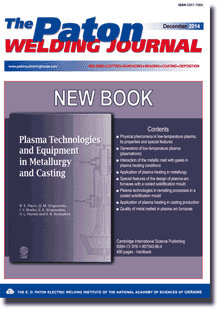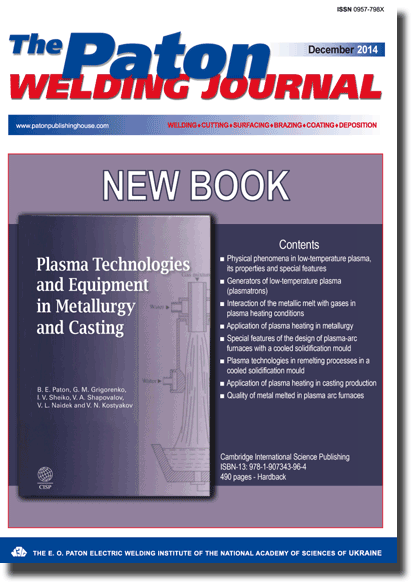| 2014 №12 (02) |
DOI of Article 10.15407/tpwj2014.12.03 |
2014 №12 (04) |

The Paton Welding Journal, 2014, #12, 11-14 pages
Effect of temperature of thermomechanical treatment on quality of dissimilar metal joints
L.Yu. Demidenko, N.A. Onatskaya And V.D. Polovinka
Institute of Pulse Processes and Technologies, NASU. 43a Oktyabrsky Ave., 54018, Nikolaev, Ukraine. E-mail:iipt@iipt.com.ua
Abstract
At present time, pressure welding methods acquire more and more distribution for quality joining of dissimilar metals. The Institute of Pulse Processes and Technologies of the NAS of Ukraine has developed a new method of welding of materials in solid state using current pulses. In essence, it lies in the fact that metals being welded at ambient temperature are pressure contracted and specific amount of current pulses of amplitude density not less than 1.2x109 A/m2 and duration not less than 2x10-4 s are passed through deformation zone for intensification of plastic deformation at stage of physical contact formation. At that mutual deformation of surface projection provides for sufficiently tight contact of surfaces being welded and allows for their isolating from ambient environment. A welded joint is formed at further heating by type of diffusion one without application of special shield of the surfaces from oxidation. Aim of present work is an investigation of effect of temperature of thermomechanical treatment on quality of joints in welding of dissimilar metals in solid state using current pulses of large density. Such research methods as mechanical shearing tests, optical metallography and micro X-ray spectral analysis were used at that. It was determined as the result of experiments that 800 °C temperature is the most favorable for providing a quality steel 20 plus copper M1 welded joint, since at that no discontinuities are present in joint zone and clearly expressed initial structure is preserved in metal itself. 9 Ref., 3 Tables, 5 Figures.
Keywords: welded joints of dissimilar metals, temperature of thermomechanical treatment, current pulses of large density, self-sealing of inter-contact zone, metallographic investigations, mechanical shearing tests
Received: 05.05.14
Published: 29.12.14
References
1. Middeldorf, K., von Hofe, D. (2008) Trends in joining technology. The Paton Welding J., 11, 33-39.
2. Reisgen, U., Stein, L., Steiners, M. (2010) Stahl-Aluminium-Mischverbindungen: Schweissen oder Loeten? Die Kombination zweier etablierter Fuegetechnologien macht Unmoegliches moeglich. Schweissen und Schneiden, 62(5), 278-284.
3. Polovinka, V.D., Yurchenko, E.S., Vovchenko, O.I. Method of diffusion welding of metals. Pat. 79181 Ukraine. Int. Cl. B23K 31/02. Publ. 25.05.07.
4. Vovchenko, A.I., Demidenko, L.Yu., Onatskaya, N.A. (2011) Intensification of plastic deformation of metal surfaces under action of current pulses in pressure welding. Naukovi Notatky: Mizhvuz. Zbirnyk, 32, 63-68.
5. Kurt, A., Uygur, E., Mutlu, E. (2006) The effect of allotropic transformation temperature in diffusion-welded low-carbon steel and copper. Metallofiz. Nov. Tekhnol., 28(1), 39-52.
6. Kazakov, N.F. (1976) Diffusion welding of materials. Moscow: Mashinostroenie.
7. Kovalenko, V.S. (1973) Metallografic reagents. Moscow: Metallurgiya.
8. Karakozov, E.S. (1976) Joining of metals in solid phase. Moscow: Metallurgiya.
9. Paton, B.E., Medovar, B.I., Saenko, V.Ya. (1980) Spontaneous cleaning of metals from oxide films. Doklady AN SSSR, 159(1), 1117-1118.
Suggested Citation
L.Yu. Demidenko, N.A. Onatskaya And V.D. Polovinka (2014) Effect of temperature of thermomechanical treatment on quality of dissimilar metal joints. The Paton Welding J., 12, 11-14.The cost of subscription/purchase order journals or individual articles
| Journal/Currency | Annual Set | 1 issue printed |
1 issue |
one article |
| TPWJ/USD | 384 $ | 32 $ | 26 $ | 13 $ |
| TPWJ/EUR | 348 € | 29 € | 24 € | 12 € |
| TPWJ/UAH | 7200 UAH | 600 UAH | 600 UAH | 280 UAH |
| AS/UAH | 1800 UAH | 300 UAH | 300 UAH | 150 UAH |
| AS/USD | 192 $ | 32 $ | 26 $ | 13 $ |
| AS/EUR | 180 € | 30 € | 25 € | 12 € |
| SEM/UAH | 1200 UAH | 300 UAH | 300 UAH | 150 UAH |
| SEM/USD | 128 $ | 32 $ | 26 $ | 13 $ |
| SEM/EUR | 120 € | 30 € | 25 € | 12 € |
| TDNK/UAH | 1200 UAH | 300 UAH | 300 UAH | 150 UAH |
| TDNK/USD | 128 $ | 32 $ | 26 $ | 13 $ |
| TDNK/EUR | 120 € | 30 € | 25 € | 15 € |
AS = «Automatic Welding» - 6 issues per year;
TPWJ = «PATON WELDING JOURNAL» - 12 issues per year;
SEM = «Electrometallurgy Today» - 4 issues per year;
TDNK = «Technical Diagnostics and Non-Destructive Testing» - 4 issues per year.


